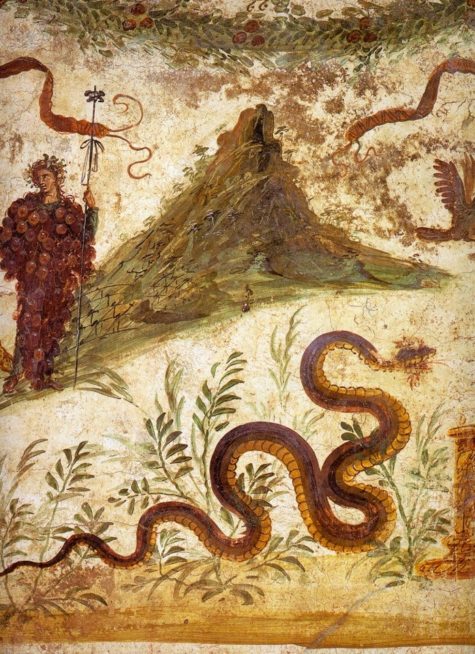- Also known as: Agatho Daemon
The Romans and Hellenistic Greeks did not like deities in the shapes of animals. They liked their spirits to resemble humans. Adopted Egyptian spirits thus adapted in form.
Agathos may be Agatho Daemon in human form; he may be an emanation of Agatho Daemon who developed into an independent spiritual entity; or he may always have been a distinct spirit.
Agathos is Lord of Vineyards and watches over fields of grain, peace, prosperity, and plenty. He bestows wisdom, good health, and good luck. Agathos was venerated at home, traditionally by a family together.
The worship of the Agatho Daimon was and is mostly a private practice. Greek families poured out a few drops of wine to him after every meal. Small offerings were sometimes left out to the daimon, which appeared as a snake around the household.
To honor the spirit, pour out libations to him, speak to him on a regular basis, asking for protection for yourself and your home. You might also make a sculpture of a snake to serve as a visual reminder of your daimon.
He shows his favor via a family’s good fortune (or lack thereof). Agathos guarantees that a family has sufficient food and drink.
- Favored people: Barkeeps, those who own vineyards or grow artisanal grain.
- Manifestations: Agathos manifests as a snake or a handsome young man.
- Attributes: Goblet, ear of wheat, poppies, cornucopia, staff or wand entwined by a snake.
- Offerings: Toast Agathos with a glass of wine at each meal; if you’re not drinking, then just set one aside for him.
The second day of every Athenian month was also a sacred day, devoted to the Agathos Daimon (good spirit). The name “daimon” does not mean the evil demon of modern Christianity, (although it did have a negative form, called the kakodaimon), but was thought to be an aspect of Zeus, as Zeus Ktesios, Charitodotes, and Epikarpios, titles as giver of increase and joy.
Agathos Daimon is most often represented in the form of a snake, a symbol of healing. However the daimon is also a function of one’s being, a characteristic inherently neither good nor bad. Hence, one prays for a good daimon, an eudaimon, and goodness from the gods for the coming month and also for the favor of father Zeus as Agathos Daimon.
Pindar, Socrates, Proclus and Plotinus mention their daemons as well. The spirit acts as a guardian against error and a guide in life.
Burkert (Greek Religion, p. 181) says that “One must be on good terms with it.” And Pindar sang that “The daimon active about me I will always consciously put to rights with me by cultivating him according to my means” (Pyth. 3.108f) and “The great mind of Zeus steers the daimon of the men whom he loves” (Pyth. 5.122f). The philosopher Sokratēs talks of his own daimon as a small voice which speaks to him and warns him to refrain from certain actions (Plato, Apology, 31d).
The myth of the Agatho Daemon can neither be proved nor disproved. “Agatho” stems from the Greek “to agathon,” meaning the highest or supreme good in a moral sense, summum bonum. Since the daemon brought both spiritual and material wealth to a household or person, the Agatho Daemon amounts to the “good spirit.”
Each person was assigned a daemon at birth, and the “good spirit” of the daemon protected and guided him through life. Sacrifices of milk and honey were made to the daemon on one’s birthday. Otherwise a cup of consecrated or spiritually pure wine was passed around at dinner, called the cup of the Agatho Daemon. As we shall see, these rituals were meant as an affirmation of life (and thus as an acknowledgement of death).
The Agatho Daemon was the “good” half of a good and evil duality. This duality was portrayed in frescoes as a serpent with the head of a lion with 7 or 12 solar rays emanating from it. The serpent portion was called the kakodaemon, representing the underworld and water, and the lion’s head was the Agatho Daemon, representing the solar fires.
The cosmic interpretation of the daemon as solar provider was tied to the household’s prosperity in the form of the genius. The lion-headed serpent was frequently pictured along with the household genius, the latter shown as a youth holding a horn of plenty and a bowl, or a poppy and ears of corn, representing the growth and abundance of harvest. The harvest imagery along with the serpent as rain and sun were all symbolic of a successful harvest.
Information about the Egyptian version of this deity, known as Agathodaemon, can be found here: Agathodaemon.
Information collected from various sources





Leave a Reply